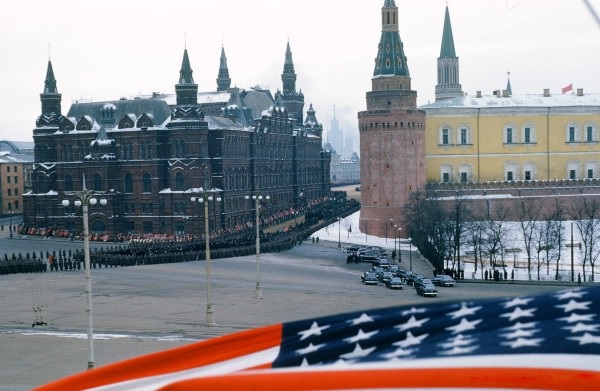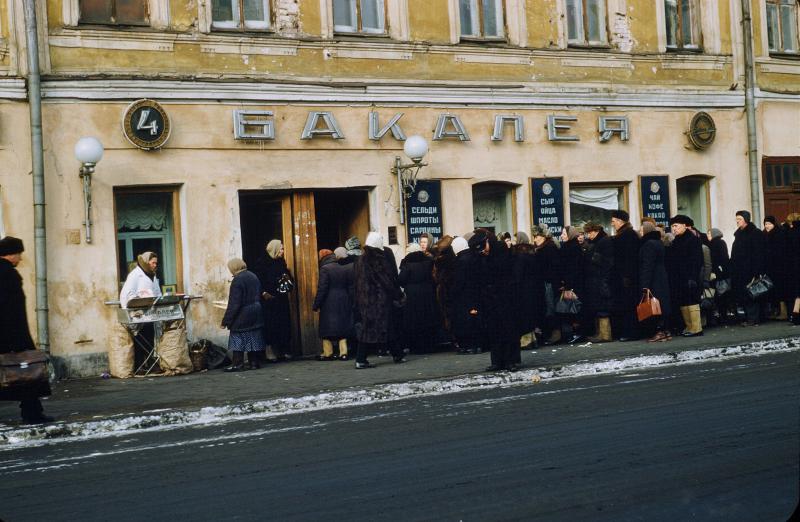The Lost Archive of Major Martin Manhoff
I had trouble finding the house. My GPS said I had arrived, but I didn’t see anything, just an overgrown lot along a typical suburban stretch of road—a Papa John’s Pizza and Dairy Queen Grill and Chill on one side, a 7-Eleven and small animal veterinarian on the other. I drove on a few blocks, made a U-turn, and headed back for another look. That’s when I saw her, waving at me from a small cut in the dense foliage.
Elizabeth Kain and I had worked together as guides on the US State Department’s exhibition Information USA in the Soviet Union back in the late 1980s. We remained good friends, and in July of last year she called to ask whether I was interested in going through a collection of Russian things left behind by an elderly couple in Kirkland, several miles east of Seattle. Not sure what to expect, I said yes, and now she was guiding me into a narrow gravel driveway. The house, invisible from the road, sat behind a tall fence. A middle-aged woman with dark hair, whom I’ll call the executrix (she wishes to remain anonymous), was waiting for us.
The house was filled with boxes and piles of stuff, much of it laid out on tables. The executrix, a friend of Elizabeth’s mother, began to tell us the story of Martin and Jan Manhoff, the owners of the house. Martin had been born in Seattle in 1917. He attended the University of Washington, majoring in art, and  then joined the US Army after graduation. He fought in Europe in the Second World War, landing on the beaches at Normandy four days after D-Day in June 1944. He returned to the States after the war and married Jeannette (Jan) Kozicki, another UW graduate, in 1950. Soon after, Martin left to learn Russian at the Army Language School in Monterey, California.
then joined the US Army after graduation. He fought in Europe in the Second World War, landing on the beaches at Normandy four days after D-Day in June 1944. He returned to the States after the war and married Jeannette (Jan) Kozicki, another UW graduate, in 1950. Soon after, Martin left to learn Russian at the Army Language School in Monterey, California.
In early 1952, Martin and Jan moved to the Soviet Union, where he was to serve as assistant military attaché in the US Embassy, then located directly across from the Kremlin on Mokhovaya Street. They remained there for two years when Martin was expelled from the USSR on espionage charges. The couple returned to Washington state and opened a small home furnishings store. They lived quietly and never had any children. Martin died in 2005, Jan in 2014.
The executrix had been close to the Manhoffs and they had selected her to dispose of their estate. She had placed all of their Russian things in a number of boxes. There were dozens of books, hundreds of postcards, and some tourist maps, but nothing of real value. It seemed like a waste of time. And then I came across a stack of 16mm metal film canisters. I picked one up and was stunned by what I saw scratched in pencil: “Stalin Funeral.” I kept digging though the boxes. I found one full of photographic slides. I took out one of the slides and held it up to the light. It was a street scene from Moscow, clearly from the 1950s, and in brilliant color. I laid the containers out on the floor: there were thousands of slides. I couldn’t believe what I was seeing. I told the executrix that Martin had left behind something special, and she asked me to take whatever I wanted and try to find a good home for it.
Over the course of the next several months I had the films and slides professionally digitized. As I started going through it all, I was soon convinced this was a major historical find. Martin had taken color photographs throughout the USSR, capturing daily life in Stalin’s Russia like nothing I had seen before. He had shot color movie footage from automobiles and trains and even captured Stalin’s funeral from the embassy. A gifted photographer, Martin had produced a unique visual record of the Soviet Union.
Curious to see if anyone would share my opinion, I posted about a dozen photographs on my Facebook page. The writer Boris Akunin saw it and commented that he found the images remarkable and then kindly shared my post on his Facebook page after I asked whether he might help me publicize the photographs. With that, the story took off.
 After a day or so I was inundated by requests for more images and additional information from news agencies in Russia, Europe, the UK, and US. In the end, I signed a contract with Radio Free Europe/Radio Liberty to do a series of stories on the Manhoff archive. The first installment—“Stalin’s Funeral”—was published online in early March, generating enormous interest. According to the Broadcasting Board of Governors, the Manhoff film of Stalin’s funeral has been viewed over 2 million times on Russian-language platforms and over 250,000 times in English. The story has been shared 20,000 times in English and Russian and has been covered by newspapers and magazines in countries around the world.
After a day or so I was inundated by requests for more images and additional information from news agencies in Russia, Europe, the UK, and US. In the end, I signed a contract with Radio Free Europe/Radio Liberty to do a series of stories on the Manhoff archive. The first installment—“Stalin’s Funeral”—was published online in early March, generating enormous interest. According to the Broadcasting Board of Governors, the Manhoff film of Stalin’s funeral has been viewed over 2 million times on Russian-language platforms and over 250,000 times in English. The story has been shared 20,000 times in English and Russian and has been covered by newspapers and magazines in countries around the world.
The entire, four-part series can now be viewed on RFE’s site. The material published so far is just a fraction of the entire archive. My plan is to donate the complete Manhoff collection (films, slides, letters, and ephemera) to the University of Washington library where it will be cataloged, preserved, and made available to the public. Before that, however, I am exploring the possibility of publishing a book featuring the best of Martin’s photographs and the story of how these beautiful and important images were taken, packed up and forgotten for over half a century, and only now rediscovered.
Comments? Please contact the author via his website.
Douglas Smith has a doctorate in history from UCLA, where he studied under the late Hans Rogger. His books include The Pearl (2008), Former People (2012), and Rasputin (2016). He is currently writing a book about American famine relief in Russia in the 1920s.
